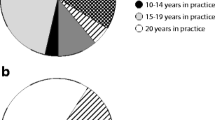Abstract
Radiation oncologists in Russia face a number of unique professional difficulties including lack of standardized training and continuing medical education. To combat this, under the auspices of the Russian Society of Clinical Oncology (RUSSCO), our group has developed a series of ongoing in-person interactive contouring workshops that are held during the major Russian oncology conferences in Moscow, Russia. Since November 2016 during each workshop, we utilized a web-based open-access interactive three-dimensional contouring atlas as part of our didactics. We sought to determine the impact of this resource on radiation oncology practice in Russia. We distributed an IRB-approved web-based survey to 172 practicing radiation oncologists in Russia. We inquired about practice demographics, RUSSCO contouring workshop attendance, and the clinical use of open-access English language interactive contouring atlas (eContour). The survey remained open for 2 months until November 2017. Eighty radiation oncologists completed the survey with a 46.5% response rate. Mean number of years in practice was 13.7. Sixty respondents (75%) attended at least one RUSSCO contouring workshop. Of those who were aware of eContour, 76% were introduced during a RUSSCO contouring workshop, and 81% continue to use it in their daily practice. The greatest obstacles to using the program were language barrier (51%) and internet access (38%). Nearly 90% reported their contouring practices changed since they started using the program, particularly for delineation of clinical target volumes (57%) and/or organs at risk (46%). More than 97% found the clinical pearls/links to cooperative group protocols in the software helpful in their daily practice. The majority used the contouring program several times per month (43%) or several times per week (41%). Face-to-face contouring instruction in combination with open-access web-based interactive contouring resource had a meaningful impact on perceived quality of radiation oncology contours among Russian practitioners and has the potential to have applications worldwide.

Similar content being viewed by others
References
Likhacheva A, Mitin T, Khmelevsky E (2017) The red beam: past, present, and future of radiation oncology in Russia. Int J Radiat Oncol Biol Phys 97:220–224
Gillespie EF, Panjwani N, Golden DW, Gunther J, Chapman TR, Brower JV, Kosztyla R, Larson G, Neppala P, Moiseenko V, Bykowski J, Sanghvi P, Murphy JD (2017) Multi-institutional randomized trial testing the utility of an interactive three-dimensional contouring atlas among radiation oncology residents. Int J Radiat Oncol Biol Phys 98:547–554
Mitin T (2016) Fundamentals of target delineation in radiation therapy for breast cancer, Feb 5, (https://www.youtube.com/watch?v=1ke6q65BYoA&fs=1) Accessed 11 Dec 2017
Jagsi R (2017) Contouring of treatment targets in breast cancer, Part 2, Feb 3, (https://www.youtube.com/watch?v=1ke6q65BYoA&fs=1) Accessed 11 Dec 2017
Fiorino C, Reni M, Bolognesi A, Cattaneo GM, Calandrino R (1998) Intra- and inter-observer variability in contouring prostate and seminal vesicles: implications for conformal treatment planning. Radiother Oncol 47:285–292
Yamazaki H, Shiomi H, Tsubokura T, Kodani N, Nishimura T, Aibe N, Udono H, Nishikata M, Baba Y, Ogita M, Yamashita K, Kotsuma T (2011) Quantitative assessment of inter-observer variability in target volume delineation on stereotactic radiotherapy treatment for pituitary adenoma and meningioma near optic tract. Radiat Oncol 6:10
Kosztyla R, Olson R, Carolan H, Balkwill S, Moiseenko V, Kwan W (2012) Evaluation of dosimetric consequences of seroma contour variability in accelerated partial breast irradiation using a constructed representative seroma contour. Int J Radiat Oncol Biol Phys 84:527–532
Hong TS, Bosch WR, Krishnan S, Kim TK, Mamon HJ, Shyn P, Ben-Josef E, Seong J, Haddock MG, Cheng JC, Feng MU, Stephans KL, Roberge D, Crane C, Dawson LA (2014) Interobserver variability in target definition for hepatocellular carcinoma with and without portal vein thrombus: radiation therapy oncology group consensus guidelines. Int J Radiat Oncol Biol Phys 89:804–813
Cui Y, Chen W, Kong FM et al (2015) Contouring variations and the role of atlas in non-small cell lung cancer radiation therapy: analysis of a multi-institutional preclinical trial planning study. Pract Radiat Oncol 5:e67–e75
Grimshaw JM, Russell IT (1993) Effect of clinical guidelines on medical practice: a systematic review of rigorous evaluations. Lancet 342:1317–1322
Author information
Authors and Affiliations
Corresponding author
Ethics declarations
Conflict of Interest
Dr. Gillespie is a co-founder of eContour. Dr. Mitin receives research funding from Novocure. No other author has any pertinent conflicts of interest or disclosures.
Rights and permissions
About this article
Cite this article
McClelland, S., Chernykh, M., Dengina, N. et al. Bridging the Gap in Global Advanced Radiation Oncology Training: Impact of a Web-Based Open-Access Interactive Three-Dimensional Contouring Atlas on Radiation Oncologist Practice in Russia. J Canc Educ 34, 871–873 (2019). https://doi.org/10.1007/s13187-018-1388-7
Published:
Issue Date:
DOI: https://doi.org/10.1007/s13187-018-1388-7




